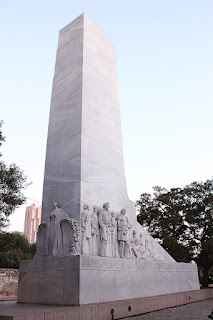NEW - Pompeo Coppini - sculptor
Italian emigrant famous for Texas monument
The sculptor Pompeo Coppini, best known for the Alamo Cenotaph in San Antonio, Texas, was born on this day in 1870 in Moglia, a village in Lombardy a few kilometres south of the city of Mantua. Coppini emigrated to the United States at the age of 26 and after initially working in New York moved to Texas, where the majority of his work can be found. The Alamo Cenotaph, also known as The Spirit of Sacrifice, consists of a 60ft high sloping shaft of grey Georgia marble resting on a base of pink Texas granite. Carved into the sides of the monument, erected near the scene of the siege of the Alamo Mission during the Texas Revolution in 1836, are images of the Alamo defenders including William B Travis, Jim Bowie, David Crockett and James Bonham, while the names of those who died at the Alamo were etched along the base. It was commissioned to commemorate the centenary of the siege and took two years to complete. It is now the centrepiece of a square known as the Alamo Plaza. The son of a musician, Pompeo moved with his family from Moglia to Florence in 1880 at the age of 10. Read more…
____________________________________
Michele Placido – actor and director
Role of anti-Mafia police inspector turned actor into a TV star
Actor and director Michele Placido was born on this day in 1946 in Ascoli Satriano in Apulia. Placido is best known for his portrayal of the character, Corrado Cattani, in the Italian television series, La piovra. Cattani, a police inspector investigating the Mafia, was the lead character in the first four series of La piovra (meaning The Octopus, a name that referred to the Mafia). It was popular on television in the 1980s and the first three series were shown in the UK on Channel Four. Placido’s family were originally from Rionero in Vulture in Basilicata and he is a descendant of the folk hero, Carmine Crocco, sometimes also known as Donatello. Crocco had fought in the service of Garibaldi but, after Italian unification, he became disappointed with the new Government and formed his own army to fight on behalf of the deposed King of the Two Sicilies, Francis II. Placido moved to Rome to study acting and then began working in films. His first success came with his portrayal of soldier Paolo Passeri in Marcia Trionfale in 1976, directed by Marco Bellocchio, a role for which Placido won an award. Read more…
____________________________________
Andrea Pirlo - footballer
Midfielder who won multiple honours with AC Milan and Juventus
The footballer Andrea Pirlo, who some commentators bracket with Roberto Baggio as one of the two best Italian footballers of the last 25 years, was born on this day in 1979. The midfielder, who left Italy to play for the Major League Soccer team New York City, has been part of six Italian championship-winning teams and is a double winner of the Champions League among a host of honours as a club player. In international football he has a World Cup winner’s medal as a member of the 2006 Italian national team that lifted the trophy in Germany. The fulcrum of the Azzurri midfield, he scored one goal and was credited with the assist for three other goals during the tournament. One of those assists resulted in the crucial opening goal for Italy scored by Fabio Grosso in the classic semi-final against the host nation. He was also one of Italy's successful penalty takers during the shoot-out that decided the final against France. He was named man of the match three times in the tournament, more than any other player. He matched that achievement six years later at Euro 2012, when Italy were beaten in the final. Read more…
____________________________________
Vittorio Orlando - politician
Prime minister humiliated at First World War peace talks
Vittorio Emanuele Orlando, the Italian prime minister best known for being humiliated by his supposed allies at the Paris peace talks following the First World War, was born on this day in 1860 in Palermo. Elected to the Chamber of Deputies for the first time in 1897, Orlando had held a number of positions in government and became prime minister in 1917 following Italy’s disastrous defeat to the Austro-Hungarian army at Caporetto, which saw 40,000 Italian soldiers killed or wounded and 265,000 captured. The government of Orlando’s predecessor, Paolo Boselli, collapsed as a result. Orlando, who had been a supporter of Italy’s entry into the war on the side of the Allies, rebuilt shattered Italian morale and the military victory at Vittorio Veneto, which ended the war on the Italian front and contributed to the collapse of the Austro-Hungarian empire, saw him hailed as Italy’s ‘premier of victory’. However, his reputation was left in tatters when he and Sidney Sonnino, his half-Welsh foreign secretary, when to Paris to participate in peace talks but left humiliated after the territorial gains they were promised in return for entering the war on the side of Britain, France and the United States were not delivered. Read more…
.jpg)
.jpg)


.jpg)


.jpg)








